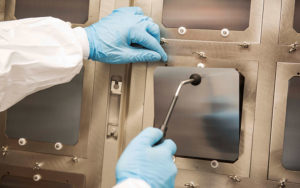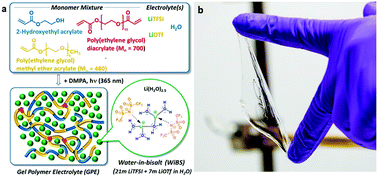(Perovskites promise boost for solar power technology)
2019/10/18 欧州連合(EU) CORDIS

© Oxford Photovoltaics Ltd, 2017
・ EU の資金提供で実施された「HYPER(Hybrid Photovoltaic Energy Relay)」プロジェクトでは、太陽電池の製造をより安価にする材料について研究。日本の研究者が発見したペロブスカイトに着目し、同材料の卓越した光吸収能力と薄膜 PV としての優れた働きを確認した。
・ 窓に組み込める半透明の太陽電池のニッチ市場を探求していたオックスフォード大学のスピンアウトである Oxford PV 社(2010 年設立)は、これを受けて方針を急転換し、ペロブスカイトとシリコンを統合するより大規模な PV 市場をターゲットにすえた。
・ ペロブスカイトセルをコーティングしたシリコン太陽電池では、シリコン単体より高いエネルギー変換効率を提供する。同社の同タイプセルでは、現在変換効率が 28%を超え(最高クラスの商用シリコンセルで約 25%)、32%の達成も近く、ペロブスカイト層を二重にすることで 40%も可能と考える。
・ 同社は 1 億ポンドを超える資本を調達し、2016 年にベルリン近くの PV 工場を取得。スイスの Meyer Burger 社の支援の下、工業向けの 156 ㎠セルの製造を準備しており、年産 200MW で 2020 年までの生産開始を見込む。
・ 同 PV 技術のポテンシャルは、現在 100GW、1 千億ポンドの PV 電力市場全体。将来的にあらゆる場所でのペロブスカイト PV による発電を予想。
・ 次には、現行の太陽電池よりも大幅に薄く軽量なペロブスカイト単体の太陽電池開発を目指す。より軽量な PV は、工場の屋根や航空機、ドローン、自動車等の輸送用アプリケーションに有用。ペロブスカイトはまた、効率的な LED ディスプレイで使用できる。
・ 欧州研究会議(ERC)の資金提供による HYPER プロジェクトは、2016 年に終了。その後はより小規模な NEM(New Energy Material)プロジェクトおよび PLE(Perovskite Light Emitters)概念実証プロジェクトがオックスフォード大学を支援した。
URL: https://ec.europa.eu/research/infocentre/article_en.cfm?artid=51065
(関連情報)
Oxford PV ウェブサイト URL: https://www.oxfordpv.com/
<NEDO海外技術情報より>
An unexpected discovery by EU-funded researchers has opened up a new field of photovoltaic technology that promises a more efficient and economical way to convert solar energy into electrical power.
Published: 18 October 2019
If solar energy is to meet its potential for replacing fossil fuels, photovoltaic (PV) technology will have to be deployed far more rapidly than it is now. In 2017 solar PV accounted for barely 2 % of global electricity production.
The EU-funded HYPER project set out to investigate several new materials that could be used to make solar cells more cheaply. Among them was a class of compounds known as perovskites, which had been studied by Japanese researchers a few years earlier but not taken further.
‘We found that perovskites absorbed light incredibly strongly and worked well in thin-film photovoltaics,’ says project coordinator Henry Snaith of Oxford University. ‘I’d spent the previous ten years searching for materials that showed some promise and this one showed a lot of promise. It was in a completely different category to where the other emerging PV materials were at the time.’
Spin-off to exploit perovskite
It was soon apparent that cells with a perovskite layer performed far better than anyone had expected and the HYPER project dropped its other lines of enquiry to find out what these new materials could do. The discovery was published in Science in 2012.
Two years earlier Snaith had founded a university spin-off company, Oxford PV, intending to exploit a niche market for semi-transparent solar cells incorporated into windows. But once the implications of the perovskite discovery became clear, the company abruptly changed direction.
‘We realised there was an opportunity to target the bigger PV market by combining perovskites with silicon,’ he says. ‘We can coat the perovskite cell on top of silicon and deliver a higher efficiency than the silicon itself.’
Oxford PV’s perovskite-silicon cells have now exceeded 28 % efficiency – the very best commercial silicon cells are around 25 % – and Snaith thinks 32 % will soon be within reach. More advanced cells, with two layers of perovskite, could approach 40 %.
0 billion market
The company has attracted more than £100 million of equity capital and in 2016 acquired a redundant PV factory near Berlin. With the assistance of Swiss technology company Meyer Burger they are preparing to produce 156 mm square cells for industrial customers. This ‘cell foundry’ will have an annual capacity of 200 megawatts and is expected to be in production by 2020.
‘The potential market for this technology is the whole of the PV power market, currently at 100 gigawatts and $200 billion,’ Snaith says. ‘On a longer time-scale we may see perovskite PV power being generated everywhere.’
He next wants to develop cells solely based on perovskites, which would be much thinner and lighter than most cells used today. ‘It opens lots of opportunities for making more lightweight PV,’ he says. ‘Things like industrial roofing – there’s quite a lot of interest for a lighter weight PV that could be deployed in a roll, for instance.’ Such cells would also be useful for transport applications such as aircraft, drones and automobiles. Beyond the PV market, perovskites could be used to make efficient light-emitting displays.
The initial project funded by the EU’s European Research Council ended in 2016; the smaller NEM (New Energy Material) and PLE (Perovskite Light Emitters) proof-of-concept projects then helped the Oxford scientists explore the potential of their discovery.
‘It was really invaluable for kick-starting my activity,’ Snaith says of the EU funding. ‘It made a very measurable difference to my ability to push ahead with this technology in competition with the rest of the world. It’s an example where applied and fundamental research are both really important and you have to be open to surprising things happening along the way.’
Project details
- Project acronym: HYPER
- Participants: United Kingdom
- Project N°: 279881
- Total costs: € 1 870 337
- EU contribution: € 1 870 337
- Duration: November 2011 to October 2016



